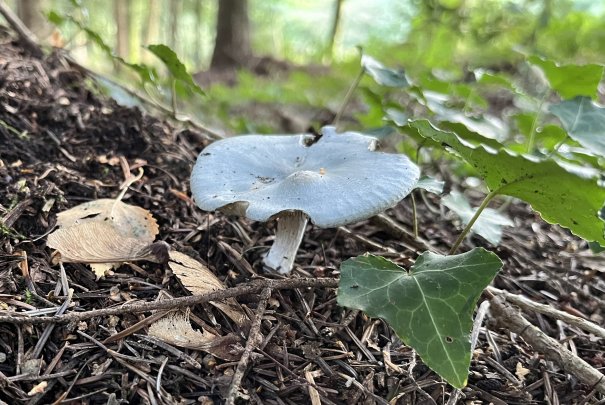Aniseed Funnel (Clitocybe odora)
Description
🔵 Clitocybe odora is a striking blue-green mushroom that grows near both deciduous and coniferous trees, often forming small groups along tree roots. Its strong anise scent (thanks to p-anisaldehyde and a hint of benzaldehyde) often reveals its presence before you even spot it! 🌿 This aroma is reminiscent of black licorice or ouzo, making it unmistakable when fresh.
🎨 Color & Identification: With its unique bluish-green to grayish-green hue and powerful anise fragrance, this mushroom is easy to recognize. However, in drier conditions, it can fade to whitish, making it trickier to distinguish from similar species if the signature scent has diminished.
Two main varieties exist:
Var. odora: White to buff gills and stem
Var. pacifica: Grayish-green to bluish-green gills and stem
🍽️ Edibility: Clitocybe odora is an edible mushroom that adds a delightful aniseed flavor to dishes. It’s particularly delicious when used in risottos, soups, or fried with onions. The unique flavor pairs especially well with white fish like plaice or cod, and powdered Clitocybe odora can even be used as a savory condiment.
📝 Important Note: While it's a good edible, young specimens should be avoided by novice foragers as they can resemble the toxic Stropharia aeruginosa.
📜 History: This mushroom was first described in 1784 by French mycologist Jean Baptiste Francois Pierre Bulliard as Agaricus odorus. It was later reclassified in 1871 by German mycologist Paul Kummer to its current genus, Clitocybe odora, meaning "sloping head" in Greek. The species name "odora" comes from Latin, referring to its perfumed scent.
Common names: Aniseed Funnel, Blue Green Aanise Mushroom, Aniseed Toadstool, Twmffat/Twndish Anis.
Mushroom Identification
🍄 Cap: 2-11 cm, starting convex with an inrolled margin, then flattening or becoming shallowly vase-shaped. Initially blue-green or greenish, it fades quickly to a paler cream or whitish color, especially in dry weather. The margin often becomes lined with age, and the texture is smooth or finely hairy.
🌸 Gills: Attached to the stem or slightly decurrent (running down the stem), close or moderately spaced, and paler than the cap. They range from whitish to pinkish buff, but in some Pacific Northwest varieties, the gills take on the same greenish hue as the cap. The gills lighten as the mushroom ages.
🦵 Stem: 2-8 cm long, 5-15 mm thick, dry, and finely hairy. Whitish in most varieties, but greenish in the var. pacifica. The base of the stem often has a copious amount of white mycelium.
🍖 Flesh: Thin, white, and quite tough. While technically edible, it’s best dried and used for its flavoring.
👃👅 Odor & Taste: A strong, unmistakable anise or licorice scent when fresh. The taste mirrors this distinctive aniseed aroma.
🌈 Spore Print: Pinkish to creamy, sometimes white, with ellipsoidal, smooth spores measuring 6-9 x 3.5-5.5 µm.
🏞️ Ecology & Habitat: Saprobic, feeding on decaying hardwood or conifer litter. Found scattered or growing gregariously in summer and fall, or in winter in warmer climates. In North America, it thrives under conifers in the west and hardwoods like beech and oak in the east. In Europe, it's commonly found under broadleaf trees, especially beech, and occasionally under conifers.
Look-Alikes
1️⃣ Stropharia caerulea 🤢
Cap: Greasy, greenish-blue when young, often covered in scales near the margin.
Smell: Does not smell of aniseed (a key distinguishing feature).
Texture: The cap is greasy or sticky to the touch.
2️⃣ Clitocybe fragrans 🍽️
Appearance: Smaller and almost pure white/pale.
Smell: Also has a strong aniseed odor, which can cause confusion.
3️⃣ Stropharia aeruginosa ☠️
Cap: Slimy, bright blue-green, fading to yellowish-green with age.
Smell: Lacks the distinctive aniseed smell.
Texture: Slimy or sticky when wet.
4️⃣ Stropharia pseudocyanea 🤢
Cap: Blue-green but often more faded or paler than Stropharia aeruginosa.
Smell: No aniseed odor.
Texture: Cap is slimy or greasy, especially when wet.
Video
Synonyms and Varietes
Agaricus odorus Bulliard (1783), Herbier de la France, 4, tab. 176 & tab. 556, fig. 3 (Basionyme) Sanctionnement : Fries (1821)
Agaricus moschatus J.F. Gmelin (1792), Systema naturae, Edn 13, 2, p. 1416
Agaricus anisatus Persoon (1796), Observationes mycologicae seu descriptiones tam novorum quam notabilium fungorum, 1, p. 44
Agaricus odorus var. ß anisatus(Persoon) Persoon (1801), Synopsis methodica fungorum, p. 323
Agaricus aerugineus Schumacher (1803), Enumeratio plantarum in partibus Saellandiae septentrionalis et orientalis, 2, p. 298
Agaricus fragrans Fries (1815), Observationes mycologicae praecipue ad illustrandam floram suecicam, 1, p. 76 (nom. illegit.)
Gymnopus odorus (Bulliard) Gray (1821), A natural arrangement of British plants, 1, p. 606
Agaricus euosmus Secretan (1833), Mycographie Suisse, 2, p. 242 (nom. inval.)
Gymnopus anisatus (Persoon) Zawadzki (1835), Enumeratio plantarum Galiciae & Bucowinae, p. 163, n° 2550
Agaricus odorus var. ß glaucoaeruginosus J. Kickx f. (1867), in J.J. Kickx, Flore cryptogamique des Flandres, 2, p. 144
Agaricus connexus Peck (1873), Bulletin of the Buffalo Society of natural sciences, 1, p. 45
Clitocybe connexa (Peck) Saccardo (1887), Sylloge fungorum omnium hucusque cognitorum, 5, p. 197
Omphalina viridis ss. Quélet (1888), Flore mycologique de la France et des pays limitrophes, p. 201
Agaricus dulcidulus Britzelmayr (1890), Bericht des naturwissenschaftlichen vereins für schwaben und Neuburg, 30, p. 14, tab. 60, fig. 356 (nom. illegit.)
Agaricus odorus f. roseolosperma Britzelmayr (1896), Botanisches centralblatt, 68, p. 110, tab. 153, fig. 724
Clitocybe dulcidula Saccardo & Traverso (1910), Sylloge fungorum omnium hucusque cognitorum, 19, p. 340
Lepista odora (Bulliard) Harmaja (1976), Karstenia, 15, p. 15
Rubeolarius odorus (Bulliard) Raithelhuber (1981), Die gattung Clitocybe (Stuttgart), 1, p. 17
Photo copyright:
All photos were taken by the Ultimate Mushroom team and can be used for your own purposes under the Attribution-ShareAlike 4.0 International license.




